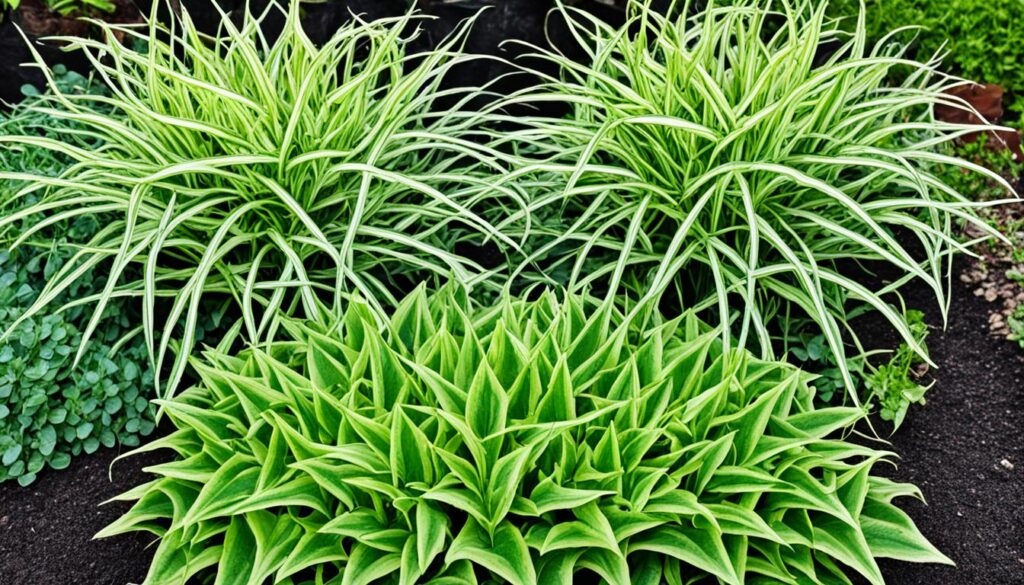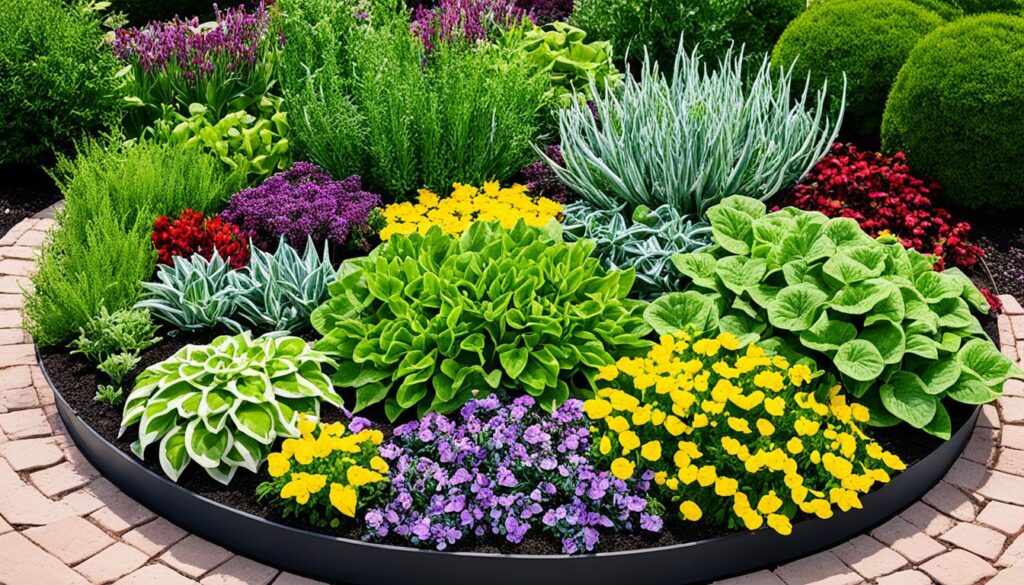Common Mistakes in Companion Planting and How to Avoid Them
Have you ever tried companion planting and seen your plants struggle? This gardening technique can boost your crops and fight pests, but it’s not easy. What mistakes do gardeners often make, and how can you dodge them?
Key Takeaways
- Companion planting can enhance crop yields and control pests, but requires understanding plant needs and interactions
- Shading, resource depletion, and allelopathic effects are some of the most common companion planting problems
- Proper plant spacing, soil preferences, and pest/disease management are crucial for successful companion planting
- Avoiding overcrowding and understanding cross-pollination issues are also important factors
- With the right knowledge, you can reap the benefits of companion planting and avoid its common pitfalls
What is Companion Planting?
Companion planting, also known as interplanting, is a way to grow different plants together. It helps plants work well with each other, like they do in nature. By choosing the right plants to grow together, you can improve pest control, make crops taste better, and increase soil health.
The Basics of Companion Planting
Companion planting is about knowing how different plants work together. You match plants based on their needs and how they help each other. This means putting tall plants with short ones, picking plants that need the same nutrients, or using some to keep pests away.
This method is all about making plants live together well. Each plant adds something to the garden. By gardening this way, you create a healthy, balanced garden that takes care of itself.
“Companion planting is not just about growing plants together – it’s about creating a harmonious and productive garden ecosystem.”
Whether you’re new to gardening or have been doing it for years, learning about companion planting can change your garden. It leads to more food, less use of chemicals, and a healthier garden.
Benefits of Companion Planting
Companion planting is a gardening method that brings many benefits to home gardeners. It helps with pollination, makes crops taste better, and keeps weeds away. This approach turns your garden into a lively ecosystem. Let’s look at the benefits of companion planting and why you should use it in your garden.
Attracting Beneficial Insects
One big plus of companion planting is drawing in pollinators. By placing certain plants together, you can attract bees, butterflies, and other helpful insects. This boosts pollination, making your crops grow better and taste sweeter.
Enhancing Crop Flavor
Companion planting also makes your crops taste better. Some plants mix well and change the flavor and smell of fruits and veggies. This is great for gardeners who want their food to be fresh and tasty.
Adding Nutrients to the Soil
Another good thing about companion planting is it helps the soil. Some plants, like legumes, fix nitrogen, which helps other plants grow. This means you might use fewer chemicals and your plants will be healthier.
Controlling Weeds
Companion planting can also help with controlling weeds. By choosing plants that stop weeds from growing, you spend less time pulling them out. This makes gardening easier and more enjoyable.
These benefits of companion planting explain why it’s popular with organic gardeners. By using this method, you can have a garden that’s beautiful, easy to care for, and full of food.
Disadvantages of Improper Companion Planting
Companion planting has many benefits like helping with pollination, making crops taste better, and fighting weeds. But, it’s important to know the downsides of not doing it right. The risks of companion planting, drawbacks of companion planting, and potential issues with companion planting can really affect your garden’s success.
One big worry is how plants fight over water and nutrients. If they’re too close, they can’t get what they need to grow well. This can make some plants grow poorly or even stop another plant from growing. It’s important to plan and space them out right.
Another issue is when taller plants shade the shorter ones. This means the shorter plants don’t get enough sunlight. They won’t grow as well or produce as much. To avoid this, think about how big each plant will get and where to put them.
Some plants also release chemicals that can slow down or even kill other plants. These risks of companion planting can be a big problem. It’s important to know which plants do this and not put them together.
“Proper planning and research are key to avoiding the drawbacks of companion planting and ensuring a thriving, harmonious garden ecosystem.”
By knowing and dealing with these risks of companion planting, gardeners can make the most of this method. They can have a garden that’s diverse, productive, and good for the planet.
Planting Tall Plants Near Short Ones
Putting tall plants next to short ones can cause shading issues. Taller crops like corn, sunflowers, or tomatoes can block sunlight from reaching plants like lettuce, radishes, or spinach. This can stunt the growth and lower the yield of the shorter plants.
To prevent shading, think about the mature size of each plant and give them enough space. This ensures all plants get enough sunlight. Trellising vining crops is also a good way to make sure all plants get enough light.
Managing Plant Heights in Companion Planting
Here are some tips for managing plant heights and avoiding shading:
- Put taller plants on the north or west side to avoid shadows on shorter ones.
- Use a mix of tall, medium, and low-growing plants for a layered look and balanced light.
- Prune or trim tall plants often to keep them from getting too tall and shading others.
- Think about using vertical growing methods, like trellises or cages, to keep tall plants off the ground and let more sunlight in.
By planning the placement and management of tall and short plants, you can prevent shading. This way, all your plants will do well in the garden.
Heavy Feeders Depleting Resources
In the world of companion planting, knowing how plants use nutrients is key. Plants like tomatoes, squash, and peppers need a lot of nutrients to grow big and produce well. These heavy feeding plants can use up the soil’s nutrients fast. This leaves plants like spinach or herbs without enough to grow.
To stop this nutrient competition, pair plants with similar needs or choose light-feeding companions. This way, you make sure all your plants get the nutrients they need to be healthy.
Adding compost or slow-release fertilizers to the soil is a good idea. It helps keep the nutrients balanced. This lets your plants live together without one taking all the nutrients.
| Heavy Feeding Plants | Lighter Feeding Companions |
|---|---|
| Tomatoes | Spinach, Basil |
| Squash | Radishes, Marigolds |
| Peppers | Lettuce, Carrots |
By knowing what your plants need and managing soil fertility in companion planting, you can make a garden where all plants thrive. No one plant will take all the nutrients, making a balanced garden.
Allelopathic Plants Inhibiting Growth
When you think about planting together, know about allelopathy. Some plants release chemicals that slow down or stop other plants from growing. This is called allelopathy and can be a big problem for gardeners and farmers.
Plants like the black walnut tree, rhododendrons, and some veggies like brassicas and fennel can be allelopathic. If you put these near other plants, they can really hurt their growth or even kill them. It’s important to know which plants don’t get along to plant well together.
Examples of Allelopathic Plants and Incompatible Combinations
- Black walnut (Juglans nigra) – Releases juglone, a compound toxic to many plants, including tomatoes, peppers, and potatoes.
- Rhododendrons – Produce grayanotoxins that can hinder the growth of neighboring plants.
- Brassicas (e.g., cabbage, broccoli, cauliflower) – Contain glucosinolates that can suppress the growth of other vegetables.
- Fennel (Foeniculum vulgare) – Releases anethole, which can inhibit the growth of tomatoes, beans, and other plants.
When you’re planning your garden or farm, make sure to check for allelopathic plants. Avoid putting these allelopathic plants near plants that inhibit growth or incompatible companion plants. This will help your garden grow well together.

Overcrowding and Poor Spacing
Beginner gardeners often make the mistake of over-planting and not spacing plants correctly. As plants grow, they need enough space to reach their full potential. If they’re too close, they can fight over roots and sunlight, leading to smaller plants and more pests.
It’s crucial to space plants right when you plant them together. Use the numbers on seed packets or tags to guide you. Wider spacing helps prevent problems like over-planting and incorrect plant spacing.
- Avoid cramming plants too close together, as this can lead to competition for resources and diminished growth.
- Respect the individual space requirements of each plant species in your companion planting setup.
- Leave enough room between plants to allow for their full development, both above and below ground.
Plan your companion plantings with the importance of plant spacing in mind. This way, you’ll get the most out of this gardening method and have a healthy garden.
| Plant | Recommended Spacing |
|---|---|
| Tomatoes | 24-36 inches apart |
| Carrots | 1-2 inches apart |
| Basil | 12-18 inches apart |
| Marigolds | 12-15 inches apart |
Remember, getting plant spacing right is key to your garden’s success. Avoid over-planting and make sure to space plants correctly. This way, you’ll have a garden that’s full of life and benefits from companion planting.
Common Mistakes in Companion Planting
Companion planting can boost your garden’s productivity and balance. But, it has its pitfalls. Knowing the common mistakes helps you get the most out of it and avoid problems.
One big mistake is planting tall crops too close to short ones. This can block sunlight, hurting the short plants. Make sure to plan your garden so all plants get enough sun.
Another mistake is pairing plants that eat too much soil nutrients. These plants might grow well at first but can harm others later. Check how much nutrients your plants need and use compost or organic fertilizers to help.
- Avoid planting tall crops too close to shorter ones to prevent shading issues
- Be mindful of heavy feeders that can quickly deplete the soil’s resources
- Steer clear of allelopathic plants that release chemicals that inhibit the growth of nearby plants
- Ensure adequate spacing to prevent overcrowding and allow for proper plant development
Some plants release chemicals that can slow down other plants’ growth. These are called allelopathic plants. Black walnut trees, eucalyptus, and some Brassica family members are examples. Make sure to check if your plants could harm others before planting them together.
Overcrowding is another big mistake. It can lead to competition for resources, more pests and diseases, and smaller plants. Give your plants enough space to grow big and healthy.
By avoiding these common mistakes, you can have a garden that’s full of life and benefits from companion planting.
Considering Plant Needs and Requirements
When planning your garden, think about what each plant needs. Things like matching plant needs in companion planting and knowing what plants need to grow well are key. These factors can make your garden a success or a failure.
Soil Preferences, Water Needs, and Growth Habits
Plants like tomatoes do well in certain soils, while lettuce prefers others. It’s important to know these differences. This way, one plant won’t take over and harm the others.
It’s also key to know how each plant grows. Pairing tall plants with shorter ones makes sure they don’t block each other. By matching their needs, you create a garden that works well together.
| Plant Characteristic | Examples | Compatibility Considerations |
|---|---|---|
| Soil pH Preference | Blueberries (acidic), Carrots (neutral) | Avoid planting blueberries and carrots together, as they have conflicting soil pH needs. |
| Water Needs | Succulents (low), Hydrangeas (high) | Pair plants with similar water requirements to prevent one from outcompeting the other for moisture. |
| Growth Habit | Pole Beans (climbing), Lettuce (low-growing) | Companion plant pole beans with low-growing crops like lettuce to avoid shading and overcrowding. |
By understanding plant requirements for companion planting, gardeners can make their plants grow better together. This way, they support each other’s growth and productivity.

“Successful companion planting requires careful consideration of the individual needs and characteristics of each plant species.”
Attracting Same Pests and Diseases
When you plant crops together, you need to think about avoiding pests and diseases. If you grow plants that pests or diseases target, these problems can spread easily. This can cause big damage to your garden.
To prevent this, mix different types of plants in your garden. This way, you make it harder for pests and diseases to find one plant to attack. It’s like making a puzzle for them, so they can’t easily spread from one plant to another.
Before you start planning your garden, look into the pests and diseases each plant can face. Check if they have the same enemies. Then, pick plants that won’t share these pests and diseases. This smart planning helps you keep pests and diseases away from your garden.
“Diversifying your garden with a variety of plants is a key strategy to prevent the spread of pests and diseases in your companion planting system.”
Think about the pests and diseases each plant can face before you plant. This way, you can make a garden that works well together. It will be less likely to have big pest and disease problems. With this careful planning, your garden will stay healthy and full of life all season.
Cross-Pollination Issues
Companion planting is a great way to garden, but watch out for cross-pollination issues. Some plants can mix their genes when grown close together. This can lead to new, unexpected plant types. It can also mess up your garden plans and make saving seeds hard.
To prevent this, know which plants can cross-pollinate. This lets you arrange your garden to reduce cross-pollination risks. By doing this, you keep your plants pure and enjoy the benefits of companion planting.
Identifying Cross-Pollinating Plants
Some plants that can cross-pollinate include:
- Tomatoes and peppers
- Squash and pumpkins
- Broccoli and cabbage
- Corn and certain bean varieties
Make sure to check the plants you want to grow and their compatibility. This way, you can avoid unwanted cross-pollination. Being proactive helps you enjoy companion planting while keeping your plants pure.
| Plant Combination | Cross-Pollination Risk | Recommended Spacing |
|---|---|---|
| Tomatoes and Peppers | High | At least 10 feet apart |
| Squash and Pumpkins | Moderate | At least 6 feet apart |
| Broccoli and Cabbage | Low | 3-4 feet apart |
| Corn and Beans | Low | 4-6 feet apart |
Understanding cross-pollination in companion planting and avoiding unintended hybrids in companion planting helps you grow a successful garden. It meets your gardening goals.
Conclusion
Companion planting is a great way to make your garden better, but you need to watch out for mistakes. Knowing about plant spacing, nutrient needs, and how plants affect each other is key. This helps you grow plants that work well together.
Understanding how to avoid common mistakes is important for gardeners. Make sure to think about what each plant needs and avoid those that use too many resources. Also, be careful with plants that can harm others.
By avoiding these mistakes, you can get many benefits from companion planting. You’ll see better pollination, tastier crops, and fewer weeds and pests. With the right knowledge and planning, your garden can flourish with companion planting.
FAQ
What is companion planting?
What are the benefits of companion planting?
What are the potential drawbacks of improper companion planting?
How can planting tall crops near shorter ones cause issues?
What problems can heavy-feeding crops cause when paired with light feeders?
How can allelopathic plants impact neighboring plants?
Why is it important to provide adequate spacing for companion plants?
What other factors should be considered when choosing companion plants?
How can pests and diseases spread in a companion planting system?
What issues can arise from cross-pollination in companion plantings?
Source Links
- 10 Must-Have Blooms for Your 2025 Garden
- The Health Advantages of Gardening You Need to Know
- How to Create a Small Vegetable Garden Layout Plan: A Beginner’s Guide
- DIY Garden Projects for Small Spaces: Upcycling Ideas to Maximize Your Garden
- Watering Techniques for Small Gardens: Ensuring Your Plants Thrive
- Small Border Plants for Landscaping: Adding Beauty and Functionality to Your Garden
- Year-Round Small Space Gardening: Seasonal Planting Tips for Maximum Harvest
- Essential Tools for Small-Space Gardening: What You Really Need
- The Ultimate Guide to Container Vegetables: What to Grow in Small Spaces
- Budget-Friendly Gardening: How to Create a Thriving Garden on a Tight Budget
- How to Optimize Sunlight in Small Gardens: Tips for Better Plant Growth
- DIY Vertical Planters: Creative Ideas for Small Space Gardening
- Companion Planting for Small Vegetable Gardens: Boost Growth and Deter Pests
- Container Gardening Essentials: Choosing the Right Pots, Soil, and Plants
- Vertical Gardening Techniques: Maximizing Your Small Space with Climbers and Vines
- How to Build a Raised Bed Garden in a Small Backyard: Step-by-Step Guide
- The Best Vegetables for Small-Space Gardens: High-Yield Varieties You Need to Grow
- Smart Vegetable Garden Layouts for Small Spaces: Maximizing Your Green Thumb in Compact Areas
- 40. Best Practices for Managing a Sustainable Garden Year-Round
- Building a Wildlife Pond for Biodiversity
- Advanced Techniques in Sustainable Gardening
- How to Create a No-Till Garden
- The Mental Health Benefits of Gardening
- Using Technology to Enhance Sustainable Gardening
- Getting Certified Organic: Steps and Benefits

Leave a Reply